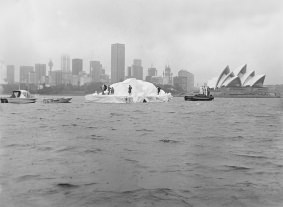[/caption]
As an April Fool’s joke in 1978, Australian businessman Dick Smith claimed he was towing an iceberg from Antarctica to Sydney Harbour. He used a barge covered with white plastic and fire extinguisher foam in effort to convince those who gathered at the harbor to see it. Apparently, however, the idea is not such a joke after all. A team of engineers from France have studied the concept, did a simulation and found that icebergs floating around in the ocean could be tethered and towed to places that are experiencing a severe drought and water shortages.
The idea originally was conceived in the 1970’s by an graduate student named Georges Mougin, who even received some funds from a Saudi prince to test the idea, but not much came of it.
According to an article on PhysOrg, the French engineers looked into the idea and concluded that towing an iceberg from, for example, the waters around Newfoundland to the Canary Islands off the northwest coast of Africa, could be done, and would take just under five months when towed by a tugboat outfitted with a kite sail, traveling at about one knot.
The cost would be almost ten million dollars, however.
According to a simulated test, the iceberg would lose only 38 percent of its seven ton mass during the trip, if it was fitted with an insulated skirt.
Apparently Mougin is encouraged by the results and now at age 86 is trying to raise money for an actual iceberg-tow.
Read more details on PhysOrg.


It sounds absurd for so many reasons.
Five months to tow it? Not exactly a prompt response time for a drought – ten million dollars of shipped bottled water would probably be far more effective.
Edit: The simulation considers a 7-tonne iceberg, which would be about 4 tonnes by the time it got there. That’s what, 4000 litres? $2500 a litre? It would probably be cheaper to dispatch cargo planes full of ice directly from the poles themselves. Or at least from the nearest fresh-water lakes.
Pulling this effort off would make a great publicity stunt or gimmick achievement, but pretending it’ll solve (or even slightly mitigate) drought conditions is, frankly, insulting to the people afflicted by drought.
actually, it’d be 4 000 000 liters.
A metric tonne is 1000kg. A litre is 1kg. So 4 tonnes would be 4000 litres.
If the cost of 10 milion is for a 30 milion ton iceberg (not clear in the physorg.com article) then that’s only 0.0003 cents/l
Wasn’t it 1978?
http://www.museumofhoaxes.com/iceberg.html
yes
OK, have updated it. Another source said 1983, but your source looks more reliable!
On the real article they talk about a 30 milion ton iceberg it sound much better
At the very beginning of Ian McDonald’s excellent sci-fi novel “River of Gods,” a gigantic iceburg many miles wide is being slowly towed up to the Ganges River Delta in an effort to kick-start the monsoon, which has been becoming increasingly unreliable due to global climate change.
I vaguely remember the original proposal. They thought they could tow a large iceberg from polar regions to the Arabia. The fractional losses went down as the iceberg got bigger, but the problems of collecting the water multiplied. The ice is white, so it reflects a lot of the light and heat, so it could take years to melt. As it melted, the water would just run into the sea, unless you get your millions of tons of ice onto land, or stick it into a giant plastic bag while still in the sea.
Plastic bag idea isn’t half-bad. In fact, why not apply the plastic bag at the source? Then losses through melt aren’t an issue at all. You’d have to be careful not to rip it, though.
Towing a plastic bag was an ‘in’ idea at the time. Have a look at ‘Dracone barges’ on Wikipedia. They were going to replace oil tankers, which seems a bit dangerous to me. But towing water is OK.
If you are towing a big iceberg, the towing losses are really small. You may actually want the ice to melt into a more streamline form. If I had to fit a plastic bag around a million-ton iceberg, and I could do that in the Red Sea, or in the Arctic, I know which one I would chose. Or, on second thoughts, I wouldn’t chose either – I would take a Dracone barge to the mouth of the Amazon and get some already melted fresh water.
What is towing icebergs to do with astronomy? Not much, but it might be planetary engineering on a big scale, so it might just about squeak in by my reckoning.
Also look up “The Dragon in the Sea” by Frank Herbert on Wikipedia. They suggest this was the inspiration of the Dracone barges. I can’t see much of a connection with astronomy either.
How is this related to space, science or astronomy?